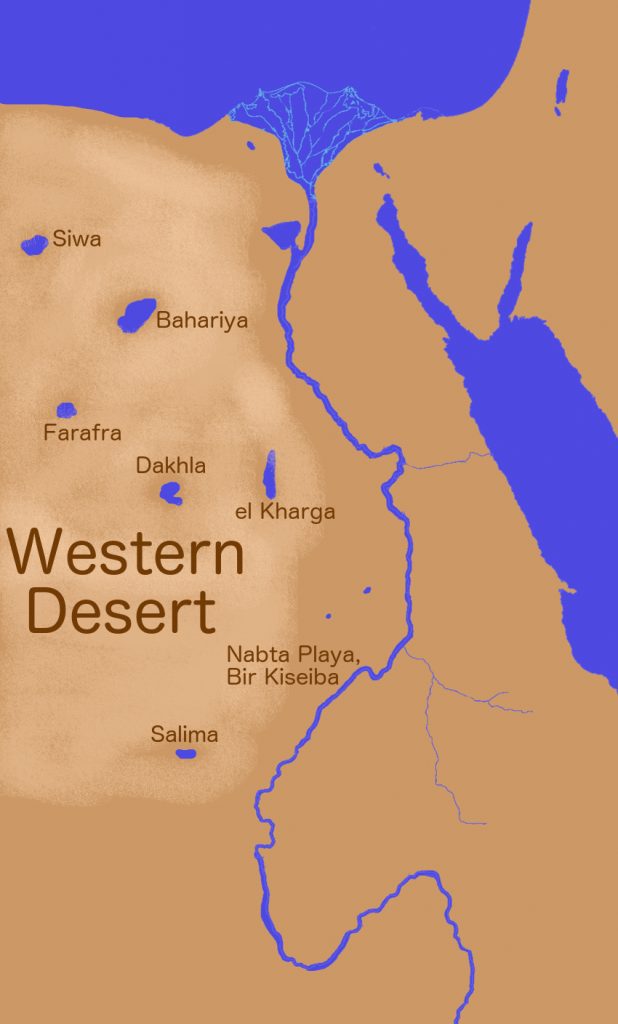Neolithic settlements have been found in southwest Asia as early as 8000 BC, but at that time there was insufficient rain to support agriculture in the Western Desert. Instead there were temporary settlements of hunter – gatherers during rainy periods. These people did not have a fully Neolithic culture, but are generally classed as Neolithic because of the presence of pottery and evidence that they may have herded cattle. The most notable areas of settlement were Nabta Playa, Bir Kiseiba, and Dakhla Oasis.
During the earliest period of Saharan Neolithic (8800 – 6800 BC) there is evidence of cattle herding. The paucity of water in the area at the time means that the cattle could not have survived there without human intervention, but we do not know whether the animals were wild or fully domesticated. It is considered likely that milk and blood were taken from the cattle, but that they were not used for their meat. By around 7500 BC people were digging their own wells in the area, some of which had a shallow basin built into one side to allow animals to drink.

Settlements in the early period were most likely temporary. There is no evidence of houses, storage pits, or wells at Nabta Playa at this time, although there are the remains of hearths in the lower part of the basins indicating settlement from early autumn to late spring. Towards the end of the period we see more permanent houses and storage pits. By the middle and late Neolithic there were slab lined houses, large bell-shaped storage pits, and wattle and daub constructions.
In the early period, tools comprised mainly of backed microlithic bladelets and grinding stones. In later periods, bifacially worked foliates and arrow heads become more common, along with simple palettes and beads.
The earliest pottery found at Nabta Playa dates to around 9800 BC. During the early and middle phases, pottery consisted of wide bowls decorated using the rocker-stamp technique with lines and points made by combs or cords. During the early period, decoration typically covered the entire exterior surface (with the exception of dotted wavy line pottery and stem and leaf pottery where the decoration was around the upper part of the vessel). The earliest forms of decoration are in the “Early Khartoum Style”, with the characteristic “dotted wavy Line Style” appearing later. They also used ostrich eggs, most likely to store water.
The small number of shards of pottery (in comparison to later periods) has led to the suggestion that pottery was not for everyday use, but instead had a symbolic and social significance. Late Neolithic pottery resembled the early forms, but with more complex decoration. However, by 4900 BC this had been replaced by burnished and smooth wares, some of which were black topped. We do not know what caused this sudden shift in style.
One of the sites at Nabta Playa from the Middle Neolithic Period consisted of a large number of cattle bones and hearths, but no evidence of any houses. Wendorf has proposed that this site was where people gathered for ceremonial occasions such as births, deaths, and marriages.
Around 7600 years ago the Western Desert became hyper arid, and the people left to find more hospitable terrain. Nabta Playa was abandoned for at least a hundred years, and when people did return they established larger settlements consisting of numerous stone lined hearths. It is during this period that the remarkable megalithic structure sometimes referred to as the “Nabta Playa Calendar Circle” was most likely constructed.
The precise dating and meaning of the Nabta Playa Stone Circle is the source of much speculation. In the vicinity, archaeologists found a series of underground clay-lined chambers containing the remains of cattle. Sometimes referred to as the “Valley of Sacrifices”, this fascinating discovery hints at the operation of a “cattle cult” and further confirms the Nabta Playa area as one of distinct religious and cultural significance for the Neolithic peoples of the Sahara.
Wendorf has suggested that contact with the culturally and social sophisticated pastoral herdsmen of the Sahara was an important stimulus in the social development of the Neolithic Cultures of Upper Egypt
Bibliography
- Allen, James P. (2010) Middle Egyptian
- Bard, Kathryn (2008) An introduction to the Archaeology of Ancient Egypt
- Brewer Douglas J. (2005) Ancient Egypt: Foundations of a Civilization
- Brewer Douglas J. (2012) The Archaeology of Ancient Egypt: Beyond Pharaohs
- Grajetzki, W (2003) Burial Customs in Ancient Egypt
- Kemp, Barry J (1991) Ancient Egypt: Anatomy of a Civilisation
- Hendrickx. S, Vermeersch, P (2000) “Prehistory”, in The Oxford History of Ancient Egypt Ed I. Shaw
- Trigger, B.G, Kemp, B.J, O’Connor. D, Lloyd. A.B (1983) Ancient Egypt, A Social History
- Wendorf. F, Schild R “Nabta Playa and Its Role in Northeastern African Prehistory” from the Journal of Anthropological Archaeology 17, 97–123 (1998)
Copyright J Hill 2016